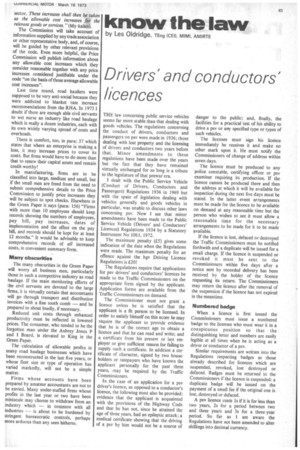know the law
Page 65

If you've noticed an error in this article please click here to report it so we can fix it.
by Les Oldridge, TEng (CEO, MIMI, AMIRTE
Drivers' and conductors' licences
THE law concerning public service vehicles seems far more stable than that dealing with goods vehicles. The regulations concerning the conduct of drivers, conductors and passengers on psv were made in 1936; those dealing with lost property and the licensing of drivers and conductors two years before that. Minor amendments to these regulations have been made over the years but the fact that they have remained virtually unchanged for so long is a tribute to the legislature of that prewar' era.
I dealt with the Public Service Vehicle (Conduct of Drivers, Conductors and Passengers) Regulations 1936 in 1969 but with the spate of legislation dealing with vehicles generally and goods vehicles in particular, was unable to discuss other laws concerning psv. Now I see that minor amendments have been made to the Public Service Vehicle (Drivers' and Conductors' Licences) Regulations 1934 by a Statutory Instrument No 1061, 1972.
The maximum penalty (£5) gives some indication of the date when the Regulations were made. The maximum penalty for an offence against the hgv Driving Licence Regulations is £20!
The Regulations require that applications for psv drivers' and conductors' licences be made to the Traffic Commissioners on the appropriate form signed by the applicant. Application forms arc available from the Traffic Commissioners on demand.
The Commissioner must not grant a licence unless he is satisfied that the applicant is a fit person to be licensed. In order to satisfy himself on this score he may require the applicant to provide evidence that he is of the correct age to obtain a licence and that he can read and write; and a certificate from his present or last employer or give sufficient reason for failing to supply such a certificate. In addition a certificate of character, signed by two householders or ratepayers who have known the applicant personally for the past three years, may be required by the Traffic Commissioners.
In the case of an application for a psv driver's licence, as opposed to a conductor's licence, the following must also be provided: evidence that the applicant is acquainted with the provisions of the Highway Code and that he has not, since he attained the age of three years, had an epileptic attack; a medical certificate showing that the driving of a psv by him would not be a source of danger to the public; and, finally, the facilities for a practical test of his ability to drive a psv or arry specified type or types of such vehicles.
The licensee must sign his licence immediately he receives it and make no other mark upon it. He must notify the Commissioners of change of address within seven days.
The licence must be produced to any police constable, certifying officer or psv examiner requiring its production. If the licence cannot be produced there and then the address at which it will be available for inspectiodduring the next five days must be stated. In the latter event arrangements must be made for the licence to be available on demand at any reasonable time but the person who wishes to see it must allow a reasonable time for the necessary arrangements to be made for it to be made available.
If the licence is lost, defaced or destroyed the Traffic Commissioners must be notified forthwith and a duplicate will be issued for a small charge. If the licence is suspended or revoked it must be sent to the Commissioners within five days after a notice sent by recorded delivery has been received by the holder of the licence requesting its return. The Commissioners may return the licence after the removal of the suspension if the licence has not expired in the meantime.
Numbered badge When a licence is first issued the Commissioners must issue a numbered badge to the licensee who must wear it in a conspicuous position so that the distinguishing letter and numbers are easily legible at all times when he is acting as a driver or conductor of a psv.
Similar requirements are written into the Regulations respecting badges as those already described for licences which are suspended, revoked, lost destroyed or defaced. Badges must he returned to the Commissioners if the licence is suspended: a duplicate badge will be issued on the payment of a small fee if the original one is lost, destroyed or defaced.
A psv licence costs Is if it is for less than two years, 2s for a period between two and three years and 3s for a three-year period. So far as I am aware the Regulations have not been amended to alter shillings into decimal currency.
























































































































